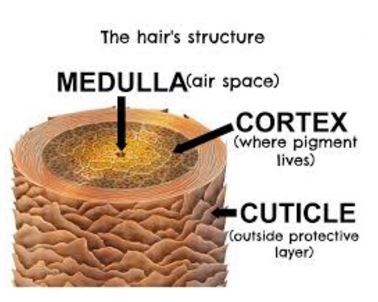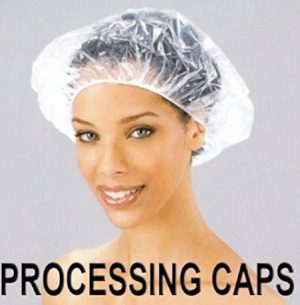Contents
Is deep conditioning really necessary?

It is often a common subject among women on various hair boards – you need to deep condition your hair often – but just what is this all about?
Let’s examine the name, the process, the advantages as well as the disadvantages, the products, the equipment, and the final thoughts on the subject.
DEFINITION
Deep-conditioning refers to the more intense absorption process of conditioner into the hair follicles once heat is applied. This application of heat allows the cuticle of the hair strand to open or lift its outer layer to allow more penetration of the conditioner into the strand. Of course, after this lifting, it is very important to ensure that it will also be closed to retain all the nourishment added during this process.
Section of Skin with Hair Shafts

Hair Structure

Each strand of hair is made up of two or three layers: the cuticle, cortex, and medulla. The cuticle is the layer we see. It is made up of flat skin cells which overlap each other somewhat like the scales on a fish’s skin. They protect the inner part of the hair strand from environmental, thermal, or simple ‘rough handling’ of the hair.
Then there is the cortex which contains the color pigment for the hair which is called melanin and is also the thickest part of the hair strand. It is basically long protein strands which twist around each other to determine the texture of your hair. It also determines the elasticity of the strand – the ability to bounce back after gently pulling on the strand.
Next, we have the medulla which is a soft, spongy mass of tissue. This part of the hair strand will be more obvious if the hair is coarse, whereas, if the hair is thin, it may not exist. Whether or not it is present, does not determine how your hair behaves.
THE PROCESS
The entire process is really a very simple one: basically, apply a heavy conditioning product to freshly washed hair (on most occasions) or before the cleansing process to dry hair. What determines which process of application all depends on personal preference as well as products being used.
Before cleansing on dry hair
If you choose to deep condition on dry hair, then more often than not, you will be using an oil-based deep conditioner (homemade or premade). Because the product being used is oily and ‘heavy’, then after the process, you would need to cleanse the hair a little more thoroughly than a normal cleansing. This is a common process for very damaged hair – extremely dry, over-processed chemically, or damaged due to thermal overuse or heat damage as it is commonly referred to.
After cleansing on wet hair
This way is the more common way to do a deep-conditioning process. The hair is cleansed by whatever method chosen – a mud wash, conditioner-wash(co-wash), or shampoo wash (preferably with sulphate-free shampoo to avoid too much stripping of the hair’s natural oils).
The actual process
Once you have chosen your process of application, you will then choose your products. After that, you apply the product to your hair generously, make sure that it is evenly distributed throughout the hair – complete coverage. After this step, the next step is the application of heat to the hair. You can apply heat to the hair by:
- Body heat – you do this by covering the hair with a plastic cap
and then allowing your own body heat to help the product to penetrate through the hair. Usually, 15-45 minutes should be adequate to ensure this.

- Using a hooded hairdryer – you cover the hair with a plastic cap and then sit under the dryer for about 15-30 minutes to allow the heat to do its job.
- Using a heating cap – a heating cap can be electrical, self-made, gel/thermal, or organic. Electrical heating caps usually come with a temperature gauge (hi-medium-lo) and this regulates the intensity of the heat being generated.
Self-made heating caps are usually warm towels wrapped around the covered hair in a plastic cap, and then covered again by another plastic cap thereby ‘trapping the heat’ while it does its job. This method usually will last anywhere between 5-15 minutes of heat generated time. The portable thermal cap which has gel packs sewn under the fabric (in the lining) and only needs to be heated for a few seconds in a microwave oven or on the stove top with hot water and will keep the heat for at least 15-30 mins.

Organic heating caps – the latest in technology whereby these portable caps are insulated with seeds (linseed or flax seeds, corn) which you preheat in the microwave oven for a few seconds/minutes depending on the manufacturer instructions. They usually generate enough heat for 15-30 minutes.
- Using a hair steamer
–
this is a little more expensive of all the methods listed here, however, it is the best. The steamer is made to open not only the cuticles but the scalp pores and your whole head really benefits from this process, as well as your facial skin.
NOTE:
To further enhance the process, you need to rinse out the conditioner with lukewarm or tepid water. This helps to re-seal the cuticle and lock in the ‘goodness’ you just spent some time ‘putting in’. Of course, if you are able to withstand a ‘cold or cooler’ rinse, the better it is for the immediate closure of the hair cuticle.
FREQUENCY
In order to fully benefit from deep conditioning, it depends on the frequency with which the process is practised. Of course, from the very first time that it is done, you will see improved results, however, the more you do the process, the more your hair benefits. I recommend doing a deep conditioning weekly if you have the time and the products or even monthly, this will certainly help your tresses.
ADVANTAGES
There are a few plus-points for deep conditioning, it:
- nourishes your hair
- moisturizes your hair
- makes your hair soft and supple to the touch
- instantly infuses product to the strand
DISADVANTAGES
As with anything, there can also be some con-points:
- the process can be time-consuming
- the cost of getting the equipment might prove a little expensive if you are not a creative type of person
- if it is done too often, it can lead to moisture overload and have a reverse effect on your hair
FINAL THOUGHTS ON THE SUBJECT
It is my opinion that having and practising a deep conditioning system for your hair will only lead to more healthy hair results. I try to deep condition at least once a month, and if my time and energy allow, then every two weeks. It has helped the condition of my hair enormously.
Give it a try, you have nothing to lose and more healthy looking and healthy feeling to your hair is what you stand to gain.
SUGGESTED PRODUCTS AND EQUIPMENT
Products:
Pre-made deep conditioning treatments like:
Morrocan Method Products (All Natural):
- Morrocan Method Floating Lotus Quick Deep Conditioner
- Morrocan Method Euro Oil Overnight Treatment
- Morrocan Method Neutral Henna
Homemade deep conditioning treatments:
Please visit my article on Coconut oil and Conditioners for some useful tips on homemade deep conditioning hair treatments.
Equipment:
Steamer
Hooded dryer
Homemade steam cap
Electric/portable steam caps
Plastic caps
I hope you found some useful information in this article. I welcome your feedback in the comments section. Thank you.




Hi Michelle,
I love that you recommend natural hair products and conditioners whenever possible. I have to admit that I am terrible when it comes to conditioning my hair. Partly because I am always rushing and just don’t spend the extra time that it takes.
But you make it sound so luxurious and great self-care, so you have me thinking that I am really going to have to start making the time to take better care of my hair.
I never really gave any thought before to the importance of heating my hair to ensure that the maximum benefit is reaped from the conditioner. I would have just used conditioner in the shower and then washed it off almost immediately. Such a waste, right?
Definitely going to change my routine having read your article! Thanks.
Hello there Susan,
Thanks for stopping by and taking the time to leave your thoughts. I prefer using natural hair products as well as much natural ‘stuff’ that I can, not just for my hair, but my whole body. I think artificial additives are proving to be a nuisance somewhat across the board – I am an advocate for ‘going green’ – but I digress! 🙂
I am glad that my article has motivated you to reconsider the whole idea of taking care of your hair. Of course, deep conditioning will make big changes to your hair; however, there will be times when you are in a pinch for time and it will be ok to just do the 1-3 minute application in the shower and rinse and be on your way – life happens – and you are not alone in that respect.
Good luck on your hair journey and I hope that you will stop by again and let me know how the deep-conditioning experience went for you!
Michelle
I have 4c high porosity hair very dry and extreme shrinkage. What do you recommend for the dryness and shrinkage
Hello Joybce,
Hmm…I would recommend a regimen of heavy-duty deep conditioning at least once a week and always moisturizing aty least every other day. My recommendation is using shea butter and here is my whipped shea butter recipe. All the best.
Michelle